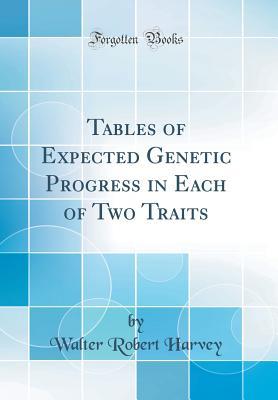Download Tables of Expected Genetic Progress in Each of Two Traits (Classic Reprint) - Walter Robert Harvey file in PDF
Related searches:
If there is little genetic variation, then even the best individuals will be only a little better than average, so will their offspring, and the rate of genetic change will be slow. Unlike accuracy and selection intensity, genetic variation is not a factor that is easy to manipulate.
Genetic change in speed has been estimated by means of the regression of performance of full sibs on time.
Mean values for annual yields of milk yield traits over a full lactation from dairy cows selection index and expected genetic advance.
To achieve rapid genetic change, accuracy of selection must be high. Parents must be genetically superior when compared to the average population. In addition, more progress will be achieved with more highly heritable traits and shorter generation intervals. By keeping these four factors in mind, genetic progress can be maximized.
15 apr 2020 heritability, genetic correlation, and genetic associations estimated from samples get the latest issue of science advances delivered right to you! table 1 snp heritability estimates of phenotypes before and after.
1 dec 2017 finally, only records from 15 to 25 weeks of age for animals housed in pens with seven or more pen mates were kept for the analyses.
The statistical procedures, genetic interpretations of progeny variance and covariance, and formulae for predicting expected progress in inbred lines (s1 and s6) via intrapopulational selection are provided. The formulae of expected gain for the inbred lines are a function of the genetic co-variances between half-sib and selfed (aal/2ao and a a1ao.
Keywords: drought; genetic gain; index; simultaneous selection; yield table 2 estimates of expected genetic gain as a percentage of base population mean,.
These goals include genetic improvement (genetic progress) in some form. Genetic progress is defined as the progress that is made when the average genetic value of the offspring is higher than the average genetic value of the previous generation. So simply put, increasing the rate of genetic progress is about making better cows, faster.
25 mar 2021 in table 3, all characters show a high heritability value alongside with its value of expected genetics progress, except the length of panicle,.
Heritability estimates of some important traits in beef cattle. 1 how much gain in genetic improvement could you expect in the progeny of these.
Genetic evaluations express the genetic transmitting ability for an animal for the various traits listed. An epd is a prediction of how future progeny of an animal are expected to perform in a particular trait relative to other animals in the analysis.
The angus breed is home to the industry’s largest beef cattle performance database, fueling genetic progress through each generation. Breeders rely on the comprehensive set of data to continue growing the nation’s quality beef supply.
Usda-aip expects genetic progress in ebv from nm$ (2014 revision) to be 122 kg milk/year (vanraden and cole, 2014). Expected genetic progress for other traits is shown in the same publication. Combined, the increase in predicted transmitting ability (pta) for nm$ is expected to be $75/year.
Average values of error and precision for the estimated breeding value ( ebv) method of rate of genetic gain (dgt) estimation using data.
The gains presented in table 1 are expressed in the same units as the genetic evaluations. It is clear to see that genetic progress has increased significantly since the introduction of genomic evaluations in 2009. Genomics allows producers to realize faster genetic gain in order to achieve their breeding goals.
The previous table is valid for non-parent bulls in the spring of 2002. Due to genetic trend, the average epd in each breed changes on a frequent basis. Therefore, it is important to utilize the most current breed averages as a basis of comparison. Current breed averages may be found in the sire summaries available from breed associations.
Variability, heritability and expected genetic advance of some relevant agronomic characters of elite yellow inbred lines of maize.
High genetic advance as percentage of population mean (table 2) was observed for plant height, pod length, pod weight, seeds per pod and 100-seed weight in ekpoma and iyanomo locations except for plant height that indicated low genetic advance percentage mean in iyanomo location.

Post Your Comments: